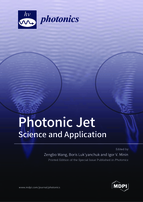Photonic Jet: Science and Application
A special issue of Photonics (ISSN 2304-6732). This special issue belongs to the section "New Applications Enabled by Photonics Technologies and Systems".
Deadline for manuscript submissions: closed (31 August 2021) | Viewed by 31187
Special Issue Editors
Interests: micro/nano-optics; nanophotonics; plasmonics; metamaterials; imaging; laser processing; solar energy; optical manipulations
Interests: nanophotonics; metamaterials; nonlinear optics; laser matter interaction
Interests: photonis; unusual optical phenomenas; mesotronics
Special Issues, Collections and Topics in MDPI journals
Special Issue Information
Dear Colleagues,
Photonic jet is a subwavelength focusing effect arising from electromagnetic waves interaction with low-loss dielectric objects, including micro and nano spheres, fiber, cubes and even biological cells and spider silks. First discovered in 2000, photonic jet has undergone significant and continued development for applications in super-resolution imaging, microscopy, fabrication, sensing, trapping, sorting, manipulation and signal amplification (e.g, Raman, photoluminescence), among others.
This special issue focuses on the recent advances on photonic jet developments, including both science and applications. Topics will include, but are not limited to:
- Label-free microscopy and imaging by photonic jet
- Sensing, trapping, manipulation and other applications of photonic jet
- Enhanced Raman scattering and photoluminescence by photonic jet
- High-index dielectric photonic jet lens
- Solid Immersion photonic jet lens
- Resonant and super-oscillation effects in photonic jet
- Metamaterial photonic jet
- Nonlinear photonic jet
- Integrated photonic jet devices
- Acoustic and Terahertz jet
- Photonic hook (curved photonic jet)
Dr. Zengbo Wang
Prof. Dr. Boris Luk’yanchuk
Prof. Dr. Igor V. Minin
Guest Editors
Manuscript Submission Information
Manuscripts should be submitted online at www.mdpi.com by registering and logging in to this website. Once you are registered, click here to go to the submission form. Manuscripts can be submitted until the deadline. All submissions that pass pre-check are peer-reviewed. Accepted papers will be published continuously in the journal (as soon as accepted) and will be listed together on the special issue website. Research articles, review articles as well as short communications are invited. For planned papers, a title and short abstract (about 100 words) can be sent to the Editorial Office for announcement on this website.
Submitted manuscripts should not have been published previously, nor be under consideration for publication elsewhere (except conference proceedings papers). All manuscripts are thoroughly refereed through a single-blind peer-review process. A guide for authors and other relevant information for submission of manuscripts is available on the Instructions for Authors page. Photonics is an international peer-reviewed open access monthly journal published by MDPI.
Please visit the Instructions for Authors page before submitting a manuscript. The Article Processing Charge (APC) for publication in this open access journal is 2400 CHF (Swiss Francs). Submitted papers should be well formatted and use good English. Authors may use MDPI's English editing service prior to publication or during author revisions.
Keywords
- photonic jet
- nanojet
- dielectric particle
- microsphere
- super-resolution







